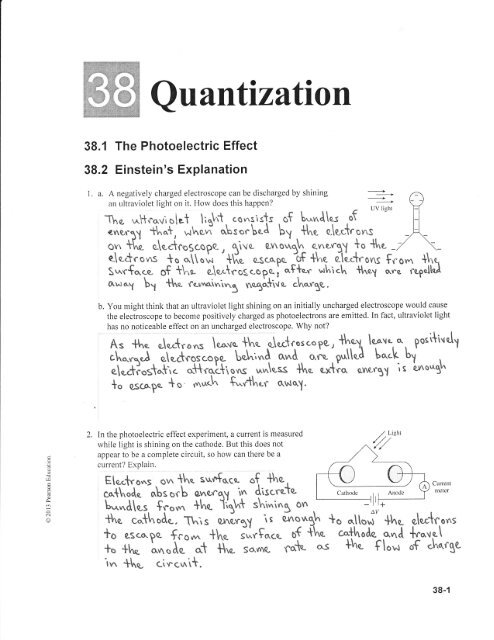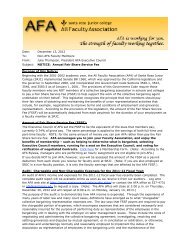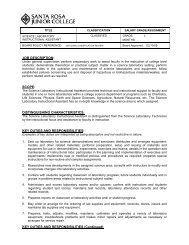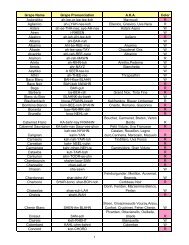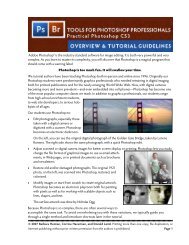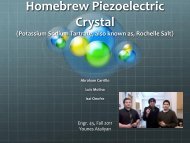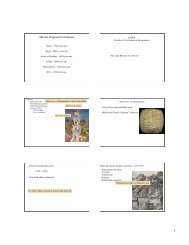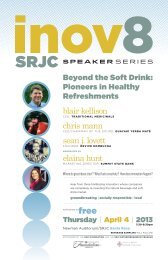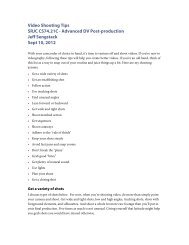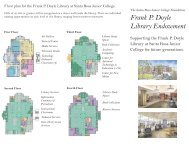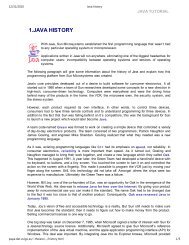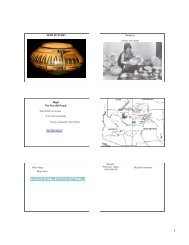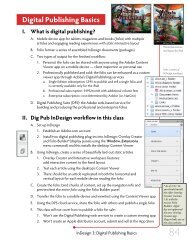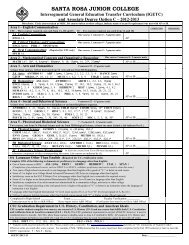Chapter 38 Workbook Solutions
Chapter 38 Workbook Solutions
Chapter 38 Workbook Solutions
You also want an ePaper? Increase the reach of your titles
YUMPU automatically turns print PDFs into web optimized ePapers that Google loves.
a<br />
t!<br />
o<br />
A<br />
O<br />
d<br />
o<br />
Wauantization<br />
<strong>38</strong>.1 The Photoelectric Effect<br />
<strong>38</strong>.2 Einstein's Explanation<br />
1. a. A negatively charged electroscope can be discharged by shining<br />
an ultraviolet light on it. How does this happen?<br />
The , Hcoviolzt l,*;t .o",,,,rt, .of b*r,J\ns tf<br />
UVright<br />
""i..r +"+,'-wha; obso.bol bv {{na, q\e,"+.o",s<br />
o* t[.o o\oitoqcooc . eiva orrrora,qh ensv"qY {o {l^c<br />
e.\e-.tro*s *o a.\\ow '{fru asc*pe -ot +he ili"{"ons fro- *hq<br />
S'.^r{o.ce of t\.o o-\e.\roscope.i o$*or "rhich *hoY qre repdleJ<br />
&r^rc1 bI tlre rc,v''nciv,in5 no5*{ivo .h*r1e.<br />
b. You might think that an ultraviolet light shining on an initially uncharged electroscope would cause<br />
the electroscope to become positively charged as photoelectrons are emitted. ln fact, ultraviolet light<br />
hu_r,lo notiggatle effect on an u1-charged e-leclroscope. Why not?<br />
As *ho o\o.{r"r* \.^u. lt^" o\**roscote, t"\<br />
l?"o,*, goti{i.nel1<br />
ch*"o.J e\e.*roscope \ro}.,l".A o.'^d o',ra- gu\lcd bo'.'k bY ,<br />
u\""ti"s\qti. o$ltolliov\s.*^\o.s 'lho o**"" a\ncrgrl is Lno*Sh<br />
+. L*po * o ^"& S'^dh"r o\Nc\Y'<br />
2. In the photoelectric effect experiment, a current is measured<br />
while light is shining on the cathode. But this does not<br />
appear to be a complete circuit, so how can there be a<br />
TiH::: o^ +\" so,-rqco of -discroto- *ha., Current<br />
melcr<br />
*+i^1i."'nbi,-orb n^o*qf i,n<br />
L.^*A[o b-^,,.',4\a.s. b*^'"d\a.s. " S*^.,- fgou^ *hc *ho ]i"U+ li:' 1i1ht shi'.inq shinin5 on '<br />
t\a. c*thode-, This a.tnc^v rs a'rnotr t o*5\" *o o,ltoni" *hc<br />
*o lo escorsc. sscorpa. S",..,.,. fcon +L' +h" J,,l*f...o J,^rf^.o o{ *hq.<br />
tthode.,o"A<br />
+; i[ l*"i;'.+ +h" ;**;--r"+" c\s ]he' flou'r<br />
i,'. *hq, circ.nil.<br />
ol*{r rt t<br />
t"..r"\<br />
"f "hqrSc<br />
<strong>38</strong>-1
<strong>38</strong>-2 cHAPTER l$ . Quantization<br />
3. Draw the trajectories of several typical photoelectrons when (a) LV =Vunode - Zcathode ) 0,<br />
(b) -4top
€<br />
E<br />
trl<br />
o<br />
o<br />
d<br />
Quantization . cHAPTER <strong>38</strong> <strong>38</strong>-3<br />
c. The current is zero for LV (E o). (K*o,*)<br />
; r = Eeto.- (:J,<br />
qnl (K-o,*)\= €qls.- (EJa.So (K*^*),((K*^x)r and<br />
Vr
<strong>38</strong>-4 cuaprcn <strong>38</strong> . Quantization<br />
9. Consider the following characteristics of the photoelectric effect:<br />
i. The generation of photoelectrons.<br />
@ ffl. existence of a threshold frequency.<br />
iii. The photoelectric cLlrrent increases with increasing light intensity.<br />
iv. The photoelectric current is independent of LV for AZ > 0.<br />
v. The photoelectric current decreases slowly as AZ becomes more negative.<br />
@rn.<br />
Qlfne<br />
stopping potential is independent of the light intensity.<br />
photoelectron current appears instantly when the light is tumed on.<br />
Which of these cannot be explained by classical physics?<br />
Nothing ivr d^ssi "ot p\ si.s "^l ox plain<br />
(^s oiposed To haU,+ \ntc,',si\) ,ss' *he<br />
*hc sioppinS potoi"lio.\ i'nlogonA""if of<br />
10. The figure shows a current-versus-potential<br />
difference graph for a photoelectric effect<br />
experiment. On the figure, draw and label graphs for<br />
the following three situations:<br />
i. The light intensity is increased.<br />
ii. The light frequency is increased.<br />
iii. The cathode work function is increased.<br />
In each case. no other oarameters of the exoeriment<br />
qre ohqnocA' i) n{qrx cr^rrQ.nt inirco.se'<br />
1 t. The figure shows u .rrr.ni-tut#3ur-il;;.?ti"s ' i<br />
graph for a photoelectric effect experiment. On the<br />
figure, draw and label graphs for the following<br />
three situations:<br />
i. The light intensity is increased.<br />
ii. The anode-cathode potential difference is<br />
increased.<br />
iii. The cathode work function is increased.<br />
In each case, no other parameters of the experiment<br />
are chaneed.<br />
-'- -"-"e-- L.) A s^orq i-.tensQ. li"ht<br />
ii.) Sovno fo, L.^+ Ii.,""<br />
iii ')9 o \ncf co'Se's '<br />
a, *htrshotd fioq*",n.y<br />
" i^sto"r* t' c1^"corr{ of<br />
lilht inntensi\.<br />
co,rASe-S Ct \o.rger C\^ffc,nt.<br />
i v,\Cr e-Ases<br />
ii, ;<br />
(\t<br />
E<br />
lJl<br />
o<br />
N<br />
o
lil<br />
o<br />
d<br />
o<br />
N<br />
o<br />
12. The figure shows a stopping potential-versusfrequency<br />
graph for a photoelectric effect experiment.<br />
On the figure, draw and label graphs for the following<br />
two situations:<br />
i. The light intensity is increased,<br />
ii. The cathode work function is increased.<br />
In each case, no other parameters of the experiment<br />
are changed.<br />
13. In a photoelectric effect experiment, the frequency of the light is increased. As a result:<br />
i. There are more photoelectrons. iii. Both i and ii,<br />
Cn.<br />
photoelectrons are faster.<br />
Explain your choice.<br />
E u\n. = hf witl olso<br />
cl,\So irncfeo,.SLS.<br />
iv. Neither i nor ii.<br />
Quantization . cHAPTER <strong>38</strong> <strong>38</strong>-5<br />
increa,sc o'!e so K^o*= Es1o.- E o<br />
14. ln a photoelectric effect experiment, the intensity of the light is increased. As a result:<br />
Qfn.r.<br />
are more photoelectrons. iii. Both i and ii.<br />
ii. The photoelectrons are faster. iv, Neither i nor ii.<br />
il il:::'n ,^i"^.e ti q\r* d"riuors a, larler nr,rmbcr e{ r,#<br />
euqrnta lo *hc- Si"fo.o ejoclinq q - \orgcr n\ wtbcf oT<br />
;i J. e\ cctr o v,s q.v\ t {horc by co,*,.sin3 q \ 6f* cr.trrenf .<br />
15. A gold cathode (work function = 5.1 eV) is illuminated with light of wavelength 250 nm. It is found<br />
that the photoelectron current is zero when LV = 0 V. Would the current change if:<br />
a. The intensity is doubled?<br />
No. $= "/t = 3xlos'./s,/"so:,lg-i* : l. !.* lgts H e<br />
$o= +. fr$qq = l.!.3* to,S He f .fo<br />
b. The anode-cathode potential difference is increased to LV = 5,5 V?<br />
No. {' fo<br />
c. The cathode is changed to aluminum (work function = 4.3 eV)?<br />
Je-s. + = e/x = 3xlo8'/t/rSo xl0-{",1 =<br />
'r .3 e\<br />
{J\" I o''sNs :1.0'l x\015<br />
l, ).x lols He<br />
ll+
<strong>38</strong>-6 cH,qprpn <strong>38</strong> . Quantization<br />
<strong>38</strong>.3 Photons<br />
16. When we say that a photon is a "quantum of light," what does that mean? What is quantized?<br />
18. Thefrequencyofabeamoflightisincreasedbutthelight'sintensityisunchanged.Asaresult:<br />
i. The photons travel faster.<br />
iii. There are fewer photons per second.<br />
19.<br />
Lig\n* cow\es ir. packets .of ensrg\. Jha f**do*o^tn\ , u*i\<br />
# \i3ht a.\ e,r.\ it o, pLoton. The'L^og1 rs qucvrtiztd.<br />
17. Theintensityofabeamoflightisincreasedbutthelight'sfrequencyisunchanged.Asaresult:<br />
i. The photons travel faster, iii. The photons are larger.<br />
ii, Each photon has more energy. (iilrn.r. are more photons per second.<br />
Which of these (perhaps more than one) are true? Explain.<br />
A r^Aore- \,',tcnsc \,qht Ae,\iu-o-rs $torg h3!,t luato {o. -tha<br />
s*.t^." ;',*f.' *oi.*<br />
"^A " l\^otoo[.{'. or,,', . pL" se.o*d in<br />
{h" ot,ro*oe\c}ri. t\ccc, sioni\or\11 o<br />
"ff"d.t .3ceotc"<br />
,^t",,lSi\1 s,reorns Yr\sfo- pho\o*i Pst Second '<br />
Gacn<br />
photon has more energy.<br />
Which of these (perhaps more than one) are true? Explain.<br />
E= hf<br />
Photons are sometimes represented by pictures like this. Just what<br />
is this a picture of? Explain what this "graph" shows.<br />
-This is a Nq{c, poclret.This is qr<br />
et"itr *i1ne*i c, v.rqvQ-<br />
" 1l,+h ^, wavc\cn5th<br />
qnd fr"q, *iL"y b*+ '{l'J {l.dt is o.[s o,\s o t s o,.i*ho't<br />
o v"t(-w\n<br />
dis.r4{g' q.',,J 'lo.o\izQ.A \iV.. o, go."*i.lc.<br />
20. Light of wavelength ),=lpm is emitted from point A,<br />
A plroton is detected 5 pm away at point B. On the<br />
figure, draw the trajectory that a photon follows between<br />
points A and B.<br />
iv. There are more photons per second.<br />
5 g.rn<br />
o<br />
d<br />
'o<br />
t!<br />
o<br />
6<br />
o<br />
A<br />
o<br />
d<br />
o
o<br />
z<br />
=<br />
o<br />
d<br />
o<br />
0.<br />
N<br />
<strong>38</strong>.4 Matter Waves and Energy Quantization<br />
Quantization . cHAPTER <strong>38</strong> <strong>38</strong>-7<br />
21. Electron I is accelerated from rest through a potential difference of 100 V. Electron 2 is accelerated<br />
from rest through a potential difference of 200 V. Afterward, which electron has the larger de Broglie<br />
wavelength? Explain.<br />
E\ertror, \. K.=loOeV Kt=<br />
r= h<br />
AmV<br />
).00 e.V v<br />
-Tl^erdo.e Vlt \, qvd So +1"'^+<br />
.\ aK<br />
-.1?<br />
1, r 1r.<br />
22. An electron and a proton are each accelerated from rest through a potential difference of 100 V.<br />
Afterward, which particle has the larger de Broglie wavelength? Explain.<br />
Nit\^ \=h/*., qnA v=]+ rh;^ \=+ =<br />
So *tr,e svna,llc,r v\^ss tor"orpo.rl, *o tha. \or3cr<br />
Nc,,*ror. t.** \. The h',qhec ,1<br />
*o o hiqhor sgcJ o.<br />
'5 ^tl<br />
Ae.t. l"^oo"ot ^r" r^ro*\J to'*'Po"J<br />
smo,l\Q,r *o.no\o.3+h .<br />
h<br />
.ltK^<br />
23. Neutron beam t has a temperature of 500 K. Neutron beam 2 has a temperature of 5 K. Which<br />
neutrons have the larger de Broglie wavelength? Explain.<br />
24. A neutron is shot straight up with an initialspeed of 100 m/s. As it rises, does its de Broglie<br />
wavelength increase, decrease, or not change? Explain.<br />
Tncreases. fs i+ rise,J'* it--a q^d moment*nn d..tu r".<br />
\hh<br />
\-T=h-v<br />
25. Double-slit interference of electrons occurs because:<br />
i. The electrons passing through the two slits repel each other.<br />
ii. Electrons collide with each other behind the slits.<br />
iii. Electrons collide with the edges of the slits.<br />
@acn<br />
electron goes through both slits.<br />
v. Tlre energy of the electrons is quantized.<br />
vi. Only certain wavelengths of the electrons fit through the slits.<br />
\^ro{q\an3+h.<br />
Which of these (perhaps more than one) are correct? Explain.<br />
\Al+V, q wcok e\a.c+ri c [covn . No cqrt send o nc ele."+ro',<br />
o*+ a |,me- *[.ro*q\ *\^o qioar o.*l s+ilt otse,rve,<br />
q\n 1r^*ur{e1-cncQ.'ir' *V,c ^t*s<br />
roso\ti".3 po.**or". df e.l.itrutrs.
<strong>38</strong>-8 cH,qpren <strong>38</strong> . Quantization<br />
26. Can an electron with a de Broglie wavelength of 2 pm pass through a slit that is lpm wide?<br />
Y* , b.^t \\ s Ai"o.\ o,^. o{{qr^ po.ssin5 }h.o^3\" is<br />
rAncef to.in .<br />
27 . The figure shows the standing de Broglie wave of a particle<br />
in a box.<br />
u<br />
a. What is the quantum number? I<br />
b. Can you determine from this picture whether the "classical" particle is moving to the right or to the<br />
left? If so. which is it? If not, why not?<br />
No,*hi. is<br />
^<br />
*J*"" wq{a- i^ thofo.^ of o st wo,vQ<br />
^Ain1.<br />
nto.,lq- \^p of \"^n"ti*'5 w^ves movins ',,n bo*h dirgz+ions.<br />
28. A particle in a box of length Zu has Et =2 eY. The same particle in a box of length Z6 has Ez = 50 eV.<br />
What is the ratio LalLb2<br />
E*= Y.]lf , E,= \ahe :<br />
8;fr / T* *<br />
ru\;<br />
Ix/uu" _ so - Lo \
<strong>38</strong>.5 Bohr's Model of Atomic Quantization<br />
<strong>38</strong>.6 The Bohr Hydrogen Atom<br />
<strong>38</strong>.7 The Hydrogen Spectrum<br />
Quantization . cHAPTER <strong>38</strong> <strong>38</strong>-9<br />
30. J. J. Thomson studied the ionization of atoms in collisions with electrons. He accelerated electrons<br />
through a potential difference, shot them into a gas of atoms, then used a mass spectrometer to detect<br />
any ions produced in the collisions. By using different gases, he found that he could produce singly<br />
ionized atoms of allthe elements that he tried. When he used higher accelerating voltages, he was able<br />
to produce doubly ionized atorns of all elements except hydrogen.<br />
a. Why did Thornson have to use higher accelerating voltages to detect doubly ionized atoms than to<br />
detect singly ionized atoms?<br />
To ..,o*" a sinq\y ioniznd dto,^.n, otto gleJco"' **t b" aor'.ouuJ<br />
4.o,- the 61*oua. A'do*b!1 ionizoA oto- fcq.rirqg Jhc re,v,novq.l of<br />
*vro. c\e.g*cons ylhich **kls rnoec. onergY qnd'thorttoce highar<br />
$,Cce\ege.{i r,q vo\to,qtS.<br />
b. What conclusion-or conclusions about hydrogen atoms can you draw from these observations? Be<br />
specific as to how your conclusions are related to the observations.<br />
H"lroo.or. e,r.,.st not hqv" two e-\sctrons tho.t can bc nc,vro{el<br />
to lrcjct.- o, do.^b\y ionizeA a*ov"r. ll1Aeolc^ hos o".\1 oylo<br />
g\q,*r o'n .<br />
3 1. If an electron is in a stationary state of an atom, is the electron at rest? If not, what does the term<br />
mean?<br />
No , th. e\q-ctron ,"tron is \^ot o* rc-s+. T+ is in o\n o\lot^tol orbi+'<br />
ott"*"a , or 1. *t"li.f 'or bi{s are, co"lloA stotton4rY<br />
\c. o",\*,<br />
stalcs. '<br />
32. The diagram shows the energy level diagram of element X.<br />
a. Wliat is the ionization energy of element X?<br />
lE,l = '1 uv<br />
E = o eV<br />
-leV-ll=3 i I 240 nnr<br />
-2cV - n=2<br />
g b. An atom in the ground state absorbs a photon, then emits a photon with a wavelength of 1240 nm.<br />
What conclusion can you draw about the energy of the photon that was absorbed?<br />
5<br />
r!<br />
o.<br />
O<br />
N<br />
ErU,oto'.,= 3c\<br />
@ c. An atom in the ground state has a collision with an electron, then emits a photon with a wavelength<br />
of 1240 nm. What conclusion can you draw about the initial kinetic energy of the electron?<br />
Eur."= 3 oV<br />
--4 eV
<strong>38</strong>-1 0 cHAPTER <strong>38</strong> . Quantization<br />
33. The figure shows a hydrogen atom, with an electron orbiting a proton.<br />
a. What force or forces act on the electron?<br />
Thc pro*o,^ exor+s a Co.^lo*b e\ec+r'r<<br />
focce on tlne. olert'on-<br />
b. On the figure, draw the electron's velocity, acceleration, and the<br />
force vectors.<br />
34. Bohr did not inclr-rde the gravitational force in his analysis of the<br />
hydrogen atom. Is this one of the reasons that his modelof the hydrogen atom had only limited<br />
success? Explain.<br />
No, thu grovilati onq\ fun..<br />
e\er*r i c fo rce .<br />
35. a. The stationary state of hydrogen shown on the left has quantum number n =<br />
b. On the right, draw the stationary state of the r -<br />
36. The n = 3 state of hydrogen has E3 = -l .51 eV.<br />
a. Why is the energy negative?<br />
1 state.<br />
Jwo Fcw pqc*is\e,s $a. dis*o.ncc<br />
;;; "ri+h<br />
Zgro. " i'"+L^ii^i' po*cnti .*"q$Y- q$y. Th.., electcon<br />
'I1nc, ele.tcon<br />
iu,["'i; +h; -irril*. atom qnA<br />
*oqethcc in tha<br />
leJs *hon O e-V.<br />
b. What is the physical significance of the specific number 1.51 eV?<br />
\,s i s *he \ir,J,irl,o q-nef qy of o.n c\ec+co''<br />
s{a*iono,ry s***e. 'ruit ir +ho hrrrovrnt of<br />
ho.vQ, *o 'oAd *o &ee *ha. e\ec*ro". to*<br />
ls h^\,\ch, rn\ch s^nltor {Lo.'n tho.<br />
q<br />
tetw"on *h"t"t r'= oa hqvq,<br />
or,d Dcoton afo<br />
S o ^"St horr. o.rn<br />
b J.^"d<br />
Ql^efsY<br />
i'' *ho n =3<br />
a\e,r3Y $e *oold<br />
*ho o4orn.<br />
d<br />
I<br />
=<br />
E<br />
o<br />
o<br />
o.<br />
d<br />
o
tr<br />
o<br />
rI]<br />
o<br />
o<br />
O<br />
N<br />
o<br />
37. Why is there no stationary state of hydrogen with E = -9 eY ?<br />
Quantization . cHAPTER 3s <strong>38</strong>-1 1<br />
T[,is is ^d o\^s af {he q, o.,,'tizel , allo*ro-b\e, ane-rg]y<br />
lo.r"ls fo" {ha hydroqon ho*, E, : - 13. 6 O e\ *nd<br />
Ex= - 3,tlo u\, o^A -1t'";" qrq "o s*tos i,r hl'lcqn<br />
{h ..t ..ro qltowool.<br />
<strong>38</strong>. Draw and label an energy level diagram for hydrogen. On it, show all the transitions by which an<br />
electron in the n = 4 state could emit a photon.<br />
n=3 - E3: -e.g{eV E*= O<br />
n:l<br />
.lffiE{.-O.85e.V<br />
E,. -l.5lcV<br />
Ea.' - 3,'{o eV<br />
€,= - 13.60 eV<br />
39. a. Which states of a hydrogen atom can be excited by collision with an electron with kinetic energy<br />
K: 12.5 eV? Explain.<br />
: -Ir.,o r,= | anl ^= 3 slo.*qs. -ll"c. ofo"t"orn cqvr |nqv\sS". up to l.l.ScV.<br />
tothe- a*oua. Et tokq-s 10. ). oV to-i*ip i" ft^" *=ta s*^te *"'d<br />
l\, oq Q-V to 1*vnp to {-he v\=3 st*te'<br />
b. After the collision, the electron:<br />
i. Bonnces off with K > 12.5 eY" @eoun".s<br />
' ii. Bounces off with K = 12.5 eY. iv. Has been absorbed.<br />
Explain your choice.<br />
';;<br />
off with K < 12'5 eY.<br />
"' of -hh" e'\c'ctron^'s in'{i o.\ alrcc'gy I s *'o^''trrol *o +h'o'<br />
" '<br />
q{onn lo'oj'.iio-"1{'i-o :"'t:+; .+1+" -il+ 'i[' ql"'{ron s+ill<br />
h.^s sovna. *^o*'.* of oncrg) lsf*.<br />
c. After the collision, the atom emits a photon. List all the possible n I m transitions that might occur<br />
as a result of this collision.<br />
Tf *hc. o.tovn i s i^i*io,.lty e*.i*cJ {o n= A. i+ .o*nll *l.o-n<br />
emit q p\o*o"t. in *h" fro,nsilio", l. + [ . If *hc- qfo-<br />
is i^i*iol\y qxcitod *o,n=3 lho possible *ro,sitions o\re<br />
3+}. -|hc.r,, I<br />
).-l$r 3+1.
<strong>38</strong>-12 cHAPTER <strong>38</strong> . Quantization<br />
40. The longest wavelength in the Balmer series is 656 nm.<br />
a, What transition is this?<br />
3-) )<br />
b. If light of this wavelength shines on a container of hydrogen atoms, will the light be absorbed? Why<br />
or why not?<br />
No. Etse^*,o.\[1 a\\ of t1.," q*ovns in o.<br />
hf{"o5o" .3"t r:t:Jt<br />
thc e,f o.,.nj sta:tc n= [ . J\tcfc. ov. v\o e\eitronS ln tlo n<br />
st..{s 'l;{ ;-(A-o,brocb'+L; o*.ig1 -o,*J<br />
i*r To lho n=3<br />
stdc,<br />
41 . a. How many electrons, protons, and neutrons are in a hydrogen-like 12 C ion ?<br />
(" pr o{ons, G nqv$ron s


